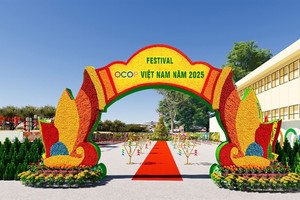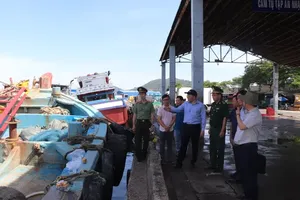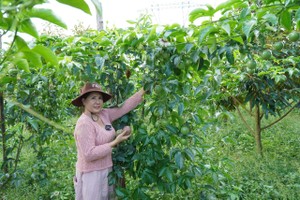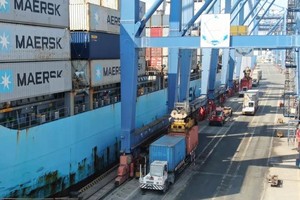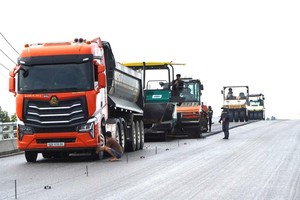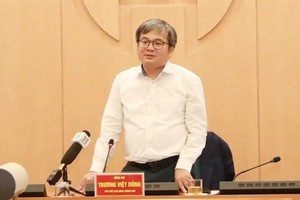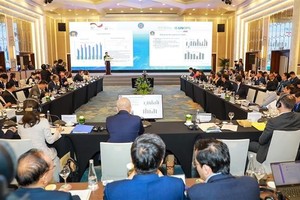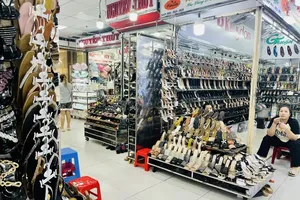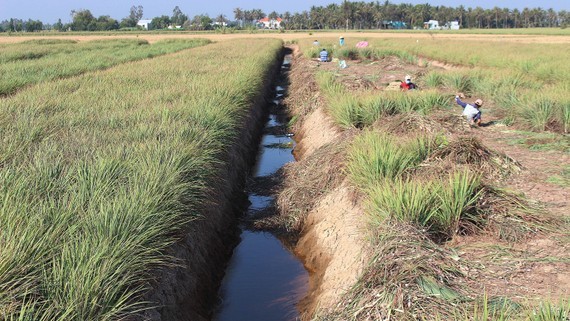 Converting from rice and crop farming to growing lemongrass in Tan Phu Dong Island District in Tien Giang Province. (Photo: SGGP)
Converting from rice and crop farming to growing lemongrass in Tan Phu Dong Island District in Tien Giang Province. (Photo: SGGP)
In the watershed area of Tan Chau Town in An Giang Province, dozens of orchards are happy because they have a bumper crop with high prices. Chin Tuoi, a farmer in Vinh Xuong Commune, has recently harvested 3.2 hectares of Hoa Loc mango, earning nearly VND100 million. “The current mango growing area used to be a low-lying rice land. Rice production was difficult, and productivity was not high. Thanks to the local investment in building the embankment, farmers switched to growing mango, earning 3-4 times higher than rice farming," said Chin Tuoi.
According to Mr. Nguyen Ngoc Ve, Chairman of the People's Committee of Tan Chau Town, the locality has nearly 700 hectares of inefficient rice land that have been converted to mango cultivation, concentrated in Vinh Xuong and Phu Loc communes. The locality is focusing on guiding people to produce according to VietGAP and GlobalGAP standards to form a large mango growing area for export.
In Tien Giang Province, many models of crop conversion to adapt to climate change, especially saline intrusion, have also resulted in significant income increases. Typically, the conversion to growing lemongrass in Tan Phu Dong District has helped people living on acid, drought, and saline soils to change their lives. The total lemongrass growing area in the district is nearly 4,000 hectares. Mr. Doan Minh Huong, Secretary of the Party Committee of Tan Dong Commune in Go Cong Dong District, said that the locality had a policy of gradually reducing the rice farming area, leaving only winter-spring rice crop instead of two crops as before, and increasing the area of crops according to VietGap standards to help local farmers have higher incomes.
In Ben Tre Province, in 2022, nearly 300 hectares of rice land have been converted to growing vegetables and grass for animal feed. According to the assessment of the local authorities, 1ha of grass can feed about 20 cows, giving an income of about VND240-270 million each year, four times higher than that of rice cultivation.
The model of industrial and semi-industrial shrimp farming in Kien Giang Province has been developing rapidly. Many areas of inefficient rice land, or inadequate irrigation water sources, have been converted to shrimp-rice and extensive shrimp farming, with an average income of VND100-130 million per ha.
Mr. Lam Minh Thanh, Chairman of the People's Committee of Kien Giang Province, said that after five years of implementing the project on restructuring production, local agriculture has grown. In the coming time, Kien Giang Province will pay special attention to modern, clean, and organic agriculture associated with the processing industry, in line with climate change adaptation.
The Ca Mau peninsula has converted the rice-growing area to the rice-shrimp production model, bringing in high and sustainable efficiency. The organic rice-shrimp farming model in U Minh Thuong, An Minh, and An Bien (Kien Giang Province) regions brings revenue 4-5 times higher than producing two rice crops. Kien Giang Province is expected to continue converting shrimp-rice production in coastal areas, such as Kien Luong and Hon Dat districts and the rest of An Minh and An Bien districts.
In Bac Lieu Province, the shrimp-rice farming model gives income 30 percent higher than rice monoculture. Earlier, farming households only earn VND50 million per ha of rice per year, but the shrimp-rice farming model has brought in VND130 million per ha per year.
The Ministry of Agriculture and Rural Development (MARD) said that in 2022, the conversion of crops on rice land in the Mekong Delta has reached over 73,000 hectares. The MARD requires functional sectors and localities in the Mekong Delta to perfect institutions and policies to support conversion on rice land; improve infrastructure, especially irrigation of the converted areas; promote research and transfer of scientific-technical advances and agricultural extension to serve the crop conversion on rice land.
According to Mr. Le Minh Hoan, Minister of Agriculture and Rural Development, the current planning of 3.5 million hectares of rice land is flexibly used. What matters is how effective the crop conversion is. When converting, localities should pay attention to the integrated value, which is the value on the same area, a geographical space, creating a higher value.
According to Mr. Nguyen Ngoc Ve, Chairman of the People's Committee of Tan Chau Town, the locality has nearly 700 hectares of inefficient rice land that have been converted to mango cultivation, concentrated in Vinh Xuong and Phu Loc communes. The locality is focusing on guiding people to produce according to VietGAP and GlobalGAP standards to form a large mango growing area for export.
In Tien Giang Province, many models of crop conversion to adapt to climate change, especially saline intrusion, have also resulted in significant income increases. Typically, the conversion to growing lemongrass in Tan Phu Dong District has helped people living on acid, drought, and saline soils to change their lives. The total lemongrass growing area in the district is nearly 4,000 hectares. Mr. Doan Minh Huong, Secretary of the Party Committee of Tan Dong Commune in Go Cong Dong District, said that the locality had a policy of gradually reducing the rice farming area, leaving only winter-spring rice crop instead of two crops as before, and increasing the area of crops according to VietGap standards to help local farmers have higher incomes.
In Ben Tre Province, in 2022, nearly 300 hectares of rice land have been converted to growing vegetables and grass for animal feed. According to the assessment of the local authorities, 1ha of grass can feed about 20 cows, giving an income of about VND240-270 million each year, four times higher than that of rice cultivation.
The model of industrial and semi-industrial shrimp farming in Kien Giang Province has been developing rapidly. Many areas of inefficient rice land, or inadequate irrigation water sources, have been converted to shrimp-rice and extensive shrimp farming, with an average income of VND100-130 million per ha.
Mr. Lam Minh Thanh, Chairman of the People's Committee of Kien Giang Province, said that after five years of implementing the project on restructuring production, local agriculture has grown. In the coming time, Kien Giang Province will pay special attention to modern, clean, and organic agriculture associated with the processing industry, in line with climate change adaptation.
The Ca Mau peninsula has converted the rice-growing area to the rice-shrimp production model, bringing in high and sustainable efficiency. The organic rice-shrimp farming model in U Minh Thuong, An Minh, and An Bien (Kien Giang Province) regions brings revenue 4-5 times higher than producing two rice crops. Kien Giang Province is expected to continue converting shrimp-rice production in coastal areas, such as Kien Luong and Hon Dat districts and the rest of An Minh and An Bien districts.
In Bac Lieu Province, the shrimp-rice farming model gives income 30 percent higher than rice monoculture. Earlier, farming households only earn VND50 million per ha of rice per year, but the shrimp-rice farming model has brought in VND130 million per ha per year.
The Ministry of Agriculture and Rural Development (MARD) said that in 2022, the conversion of crops on rice land in the Mekong Delta has reached over 73,000 hectares. The MARD requires functional sectors and localities in the Mekong Delta to perfect institutions and policies to support conversion on rice land; improve infrastructure, especially irrigation of the converted areas; promote research and transfer of scientific-technical advances and agricultural extension to serve the crop conversion on rice land.
According to Mr. Le Minh Hoan, Minister of Agriculture and Rural Development, the current planning of 3.5 million hectares of rice land is flexibly used. What matters is how effective the crop conversion is. When converting, localities should pay attention to the integrated value, which is the value on the same area, a geographical space, creating a higher value.

